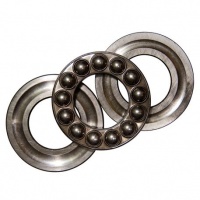The washer will not create anything – sorry. This is a difficult question to answer, Woolfie, not because the science is hard but because I do not know where you are starting from. If I make assumptions (such as that you know about Newton's Laws of force and motion) then you might struggle if you are not up to speed on the science, but if I really do start from square one, you are likely to consider me a patronising old fart.
Basically, look at a boat propeller, and this turns, providing a force trying to push the boat forwards. This force happens because the propeller is pushing the water backwards. What stops the force back from the water from pushing the propeller shaft into the boat? Well it has to have something to push against. And to stop this thing (whatever it is) from wearing out as the prop shaft pushes against it, we add a device designed to resist the force without wearing out. This 'thing' is called a thrust bearing. It holds the prop shaft in place (up and down and side to side) so the water does not get into the boat, but its main job is to resist the push of the prop shaft.
In practice, a shoulder on the shaft might push against a washer fitted to the boat – this is a very basic thrust bearing. But the turning combined with the continuous force will wear it out, so we try oil and grease – which are an improvement. But the turning action squeezes out the lubricant, and the continuous force does not allow any slack to allow more lube in. So, special self-lubricating material (such as wood or plastic or metal impregnated with oil or graphite, etc) is used, and there still needs to be a smooth flat surface to push against, so this is what the washer provides. Clever thrust bearings can include steel balls or rollers to avoid the sliding, or the use of swivelling plates which tilt under load to allow lubricant in (as mentioned by Bob Brown above).
I hope this helps, but do ask again if there are gaps in the explanation for you.
Regards, Tim
PS: I am reminded of a student who was puzzled by an explanation of how a car engine works. After several frowns, he said 'Does petrol burn, then?'
John Rudd.







